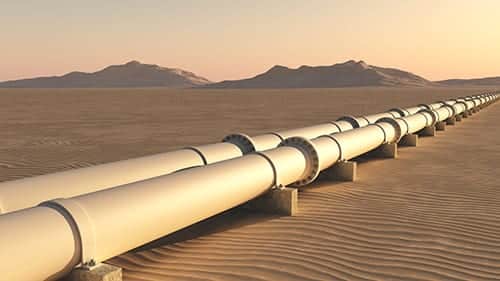Clogging of oil and gas pipelines can have significant consequences. One notable example—clogging of an outlet pipe in the large containment dome intended to block the leak from the broken wellhead resulting from the Deepwater Horizon oil rig explosion. The wellhead continued to leak for an additional four months before an alternative solution was devised. The culprit in this case was a methane clathrate, a mixture of frozen water, and methane. Clathrates are also known as gas hydrates and consist of gases trapped in water molecules as crystalline solids. They are found on seafloors around the world and in permafrost soils in the Arctic. Additionally, they can precipitate from petroleum or drilling fluids at low temperatures and/or high pressure if they contain high concentrations of water. When the latter happens inside a pipe, it can lead to clogging and reduced flow rates—and ultimately rupture due to pressure building. Gas hydrates are also explosive, and blockages created by their deposition have the potential to result in catastrophic failure.
Traditional methods for preventing clathrate precipitation include insulation of pipelines and the additional of glycol- or alcohol-based anti-freeze additives, as well as heating of pipeline walls and depressurization. Insulating or heating miles of pipeline is expensive, however, and the additives can have potentially negative environmental impacts and are not always effective. According to Kripa Varanasi, an associate professor of mechanical engineering at Massachusetts Institute of Technology (MIT), the use of existing flow assurance measures costs hundreds of millions of dollars per year.
Varanasi and colleagues at MIT have developed an alternate solution (https://news.mit.edu/2017/researchers-design-coatings-prevent-pipeline-blowouts-0414)—a textured coating that, when applied to the inner surfaces of pipes, promotes the formation of a water-barrier layer comprising liquid hydrocarbons present in the petroleum. This thin surface layer naturally repels water and prevents adhesion of ice particles or water droplets on the pipeline walls, and thus clathrate buildup. As a passive technology, the coating does not consume any additional energy or materials once applied.
The new coating is similar to technology being commercialized by a company Varanasi established that are designed to prevent the contents of containers—ketchup, paint, etc. —from sticking to the container walls. This coating system consists of an applied textured coating and an added lubricant that is trapped in the coating and forms the slippery surface. With the new pipeline coating, the lubricant is provided by the material being transported in the pipe.
Laboratory tests were conducted using cyclopentane as a substitute for methane because methane clathrates only form under high-pressure conditions that are difficult to produce in the lab. The results were promising, with no observed adhesion of gas hydrates to the substrates protected with the new coating.
There are some challenges to the practical application of the coating. Coatings have not been used in the past for pipelines because they have been too expensive. The researchers will need to demonstrate that manufacture and use of the coating can be achieved cost-effectively. In addition, the coating will need to prevent clathrate formation for the entire lifetime (several decades) of any pipeline for which it is used, because recoating the interior surfaces of installed pipe that is in use is not possible. That means the coating will need to withstand constant exposure to extreme temperature and pressure conditions. Testing of the coating’s performance under conditions that better simulate actual flow conditions in real pipelines is needed.
The work was published in journal ACS Applied Materials and Interfaces.
